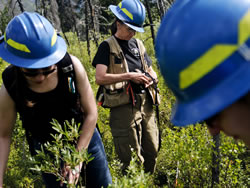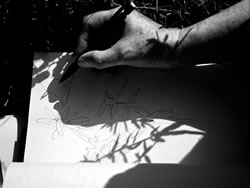National Cohesive Wildland Fire Management Strategy Success Story
In a Time of Change: The Art of Fire
Denali National Park and Preserve, Alaska
Cohesive Strategy - Fire-Adapted Communities
2011

Fire ecologist and artists study and interpret the 2002 Horseshoe Lake Fire. NPS Photo.

An artist sketches the shadows of Labrador Tea at the 2002 Horseshoe Lake Fire. NPS Photo.
On a warm and sunny day in late July 2011, artists, fire ecologists, and Denali National Park and Preserve wildland fire and interpretive staff explored, studied, and artistically interpreted the 2002 Horseshoe Lake Fire near Denali National Park and Preserve headquarters. The Alaska Fire Science Consortium, the Bonanza Creek Long Term Ecological Research Station at the University of Fairbanks, and the Fairbanks Art Association formed a partnership that brought this group of individuals together to engage the arts and humanities with fire management and science to promote understanding of the science behind fire management in the context of Alaska’s changing ecosystems.
At the burn site of the Horseshoe Lake Fire, Alaska national parks fire ecologist Jennifer Barnes spoke about the role of fire and showed artists how to analyze plant succession post-fire by measuring soil temperature depths, tree density, and dominant species. Throughout the day, Denali National Park and Preserve assistant fire management officer Charlie Reynar led conversations about the complexities of wildland fire: fire in Alaska, the fire triangle, vegetation and burn mosaics, climate change and its effects on fire, and park management strategies. Between the discussions, artists interpreted the information into field sketches.
Artists have participated in several field site excursions prior to and after visiting Denali National Park and Preserve. They will create a body of work of up to 10 pieces based upon the theme of In a Time of Change: The Art of Fire for a 2012 professional art exhibit in Fairbanks, Alaska. A community art show will also highlight art from the fire management community. The goal of the exhibits is to integrate scientific and artistic perspectives on climate change in interior Alaska as it relates to fire, fire management practices, and the resulting changes to the ecosystem. This project was funded by the Joint Fire Science Program.
For more information about the Alaska Fire Science Consortium and the 2012 fire art show, visit the Alaska Fire Science Consortium website. For information about Alaska national parks, visit Wildland Fire Management Program.
Contacts
- Jennifer Barnes, Regional Fire Ecologist, (907) 455-0652
- Charlie Reynar, Assistant Fire Management Officer, (907) 683-9549.